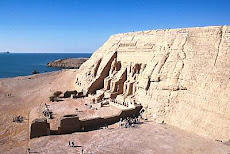Abu Simble is an archaeologica l site comprising two massive rock temples in southern Egypt on the western bank of Laka Nasser about 290 km southwest of Aswan. It is part of the UNESCO World Heritage Site known as the “Nubian Monuments”, which run from Abu Simble downriver to Philae (near Aswan).Perhaps after the Giza pyraminds, or coincident with them, the great temple of Abu Simble presents the most familiar image of ancient Egypt to the modern traveler and reader.
l site comprising two massive rock temples in southern Egypt on the western bank of Laka Nasser about 290 km southwest of Aswan. It is part of the UNESCO World Heritage Site known as the “Nubian Monuments”, which run from Abu Simble downriver to Philae (near Aswan).Perhaps after the Giza pyraminds, or coincident with them, the great temple of Abu Simble presents the most familiar image of ancient Egypt to the modern traveler and reader.
The twin temples were originally carved out of the mountainside during the reign of pharaoh Ramesses II in the 13th century BC, as a lasting monument to himself and his queen Nefertari, to commemorate his alleged victory at the Battle of Kadesh, and to intimidate his Nubian neighbours. However the complex was relocated in its entirety in the 1960 s, on an artificial hill made from a domed structure, high above the Aswan dam reservoir.
The relocation of the temples was necessary to avoid their being submerged during the creation of Lake Nasser, the massive artificial water  reservoir formed after the building of the Aswan dam on the Nile River. Abu Simbel remains one of Egypt’s top tourist attractions.
reservoir formed after the building of the Aswan dam on the Nile River. Abu Simbel remains one of Egypt’s top tourist attractions.
Construction
Construction of the temple complex started in approximately 1244 BC. Known as the “Temple of Ramesses, beloved by Amun”, it was one of six rock temples erected in Nubia during the long reign of Ramesses II With the passage of time, the temples fell into disuse and eventually became covered by sand.Already in the 6th century BC, the sand coveredthe statues of the main temples up to their knees. The temple was forgotten until 1813, when Swiss orientalist JL Bur ckhardt found the top frieze of the main temple.
ckhardt found the top frieze of the main temple.
The salvage of the Abu Simbel temples began in 1964, and cost some USD $40 million. Between 1964 and 1968, the entire site was cut into large blocks (up to 300 tons aneraging 200 tons), dismantled and reassembled in a new location – 65 m higher and 200 m back from the river, in what many consider one of the greatest feats of archaeological engineering.
Some structures were even saved from under the waters of Lake Nasser. Today, thousands of tourists visit the temples daily.The Great temple at Abu simbel, which took about twenty years to build, was completed around year 24 of the reign of Ramesses the Great (Wich corresponds to 1265 BCE). It wasdedicated to the gods Amun, Ramesses Horakhty, and ptah, as well as to the deified Ramesses himself.

